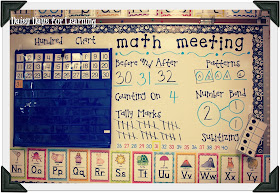Counting is something that is so simple, yet so important for primary learners! Most people (who are not teachers) don't get why counting is such an important part of math for young children, especially kindergarten. Just think about it! An entire domain is dedicated to counting and cardinality in kindergarten and both first and second grade have a standard that is dedicated to counting.
Kindergarten Counting and Cardinality Domain
First Grade Standard
Second Grade Standard
Why is counting so important you may ask?
Let's think....
When you add, what are you doing? Putting two or more groups together to get a total. Well, if you can't count, how will you know how many are in each group?
When you subtract, what are you doing? Taking some away from a group. If you can't count, how will you know how many to take away and how many are left?
And that is just the beginning! Multiplying and dividing also depend on the ability to count.
So if counting is this important, the question is....
How can we (teachers) support it in our classroom? I would like to share some pictures and ideas of how I support counting in my classroom. Hopefully, you will find something that you can use!
Every morning we count how many days that we have been in school. We count by both ones and tens, but you could also count by 2's or 5's.
To go along with our "how many days?" discussion, we also have Math Meeting. I began doing Math Meeting when I noticed that my students were struggling with the before and after, as well as, the counting on from a number other than one. I modeled my Math Meeting board after the PNOA (Primary Numbers Operation Assessment), which is the assessment used with OGAP (click {here} to learn more).
**Since I took this picture, I have changed how I do the tally marks sections. Instead of tally marks for the days we have been in school, I just choose a random number for the students to tally.**
Daily Math is a quick five minute assessment that I use to see how well my students understand numbers.
I write the number for the day on the Daily Math board and my students fill out the page below. This lets me see who is able to write both the number and number word correctly, as well as tally and represent the number in two ways (ten frame and by drawing a picture). You can grab a copy of this recording page by clicking {here}.
I also have a counting jar that will eventually be added to our daily math by the students having to count the objects in the jar to find the number of the day. Right now, they just count the objects and record the amount on a post-it as one of their station activities.
We created these anchor charts together as each number was introduced. Anchor charts for number 6 - 10 will be coming soon!
We looked at all the different ways that we can represent the numbers using Tara West's Number Sense Pack. My students also use this bulletin to help them with writing the number word for Daily Math.
I had these number anchor charts (I can't remember where I found them at the moment!) that I just loved but didn't know what to do with, so I put them on the side of my file cabinet. Throughout the day, I catch students walking by and counting the dots on the ten frames and finger tracing the numbers and number words.
Here are the number lines that you can find in my classroom! I see students using these throughout the day to help with number writing, counting, and before & after. Number lines are such an important aspect of ANY classroom, not just primary ones. To learn about how to make a bead number line, check out my post {here}
We are constantly counting in my classroom! From counting the days in school to how many students are there for the day to people who brought lunchboxes that day, counting is a very important part of the daily routine in my classroom. I hope that you were able to take something away from this (long) blog post! I would love to hear about how you support counting in your classroom! Please comment and share so that we can all get even more great ideas!





















































